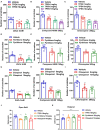The Role of Transient Receptor Potential A1 and G Protein-Coupled Receptor 39 in Zinc-Mediated Acute and Chronic Itch in Mice
- PMID: 35095413
- PMCID: PMC8790520
- DOI: 10.3389/fnmol.2021.768731
The Role of Transient Receptor Potential A1 and G Protein-Coupled Receptor 39 in Zinc-Mediated Acute and Chronic Itch in Mice
Abstract
Itching is a common symptom of many skin or systemic diseases and has a negative impact on the quality of life. Zinc, one of the most important trace elements in an organism, plays an important role in the regulation of pain. Whether and how zinc regulates itching is largely unclear. Herein, we explored the role of Zn2+ in the regulation of acute and chronic itch in mice. It is found that intradermal injection (i.d.) of Zn2+ dose-dependently induced acute itch and transient receptor potential A1 (TRPA1) participated in Zn2+-induced acute itch in mice. Moreover, the pharmacological analysis showed the involvement of histamine, mast cells, opioid receptors, and capsaicin-sensitive C-fibers in Zn2+-induced acute itch in mice. Systemic administration of Zn2+ chelators, such as N,N,N',N'-Tetrakis(2-pyridylmethyl)ethylenediamine (TPEN), pyrithione, and clioquinol were able to attenuate both acute itch and dry skin-induced chronic itch in mice. Quantitative polymerase chain reaction (Q-PCR) analysis showed that the messenger RNA (mRNA) expression levels of zinc transporters (ZIPs and ZnTs) significantly changed in the dorsal root ganglia (DRG) under dry skin-induced chronic itch condition in mice. Activation of extracellular signal-regulated kinase (ERK) pathway was induced in the DRG and skin by the administration of zinc or under dry skin condition, which was inhibited by systemic administration of Zn2+ chelators. Finally, we found that the expression of GPR39 (a zinc-sensing GPCR) was significantly upregulated in the dry skin mice model and involved in the pathogenesis of chronic itch. Together, these results indicated that the TRPA1/GPR39/ERK axis mediated the zinc-induced itch and, thus, targeting zinc signaling may be a promising strategy for anti-itch therapy.
Keywords: GPR39; Itch; TRPA1; Zn2+; p-ERK.
Copyright © 2022 Hu, Fu, Fu, Wang, Wang, Zhang, Xu, Zhou, Chen and Liu.
Conflict of interest statement
The authors declare that the research was conducted in the absence of any commercial or financial relationships that could be construed as a potential conflict of interest.
Figures









Similar articles
-
Formalin Itch Test: Low-Dose Formalin Induces Histamine-Independent, TRPA1-Mediated Itch in Mice.Front Med (Lausanne). 2021 Feb 15;8:627725. doi: 10.3389/fmed.2021.627725. eCollection 2021. Front Med (Lausanne). 2021. PMID: 33681255 Free PMC article.
-
Acid-sensing ion channel 3 is required for agmatine-induced histamine-independent itch in mice.Front Mol Neurosci. 2023 Mar 1;16:1086285. doi: 10.3389/fnmol.2023.1086285. eCollection 2023. Front Mol Neurosci. 2023. PMID: 36937045 Free PMC article.
-
Long-term anti-itch effect of botulinum neurotoxin A is associated with downregulation of TRPV1 and TRPA1 in the dorsal root ganglia in mice.Neuroreport. 2017 Jun 14;28(9):518-526. doi: 10.1097/WNR.0000000000000779. Neuroreport. 2017. PMID: 28410268
-
GPR39 Zn(2+)-sensing receptor: a new target in antidepressant development?J Affect Disord. 2015 Mar 15;174:89-100. doi: 10.1016/j.jad.2014.11.033. Epub 2014 Nov 26. J Affect Disord. 2015. PMID: 25490458 Review.
-
The zinc sensing receptor, ZnR/GPR39, in health and disease.Front Biosci (Landmark Ed). 2017 Mar 1;22(9):1469-1492. doi: 10.2741/4554. Front Biosci (Landmark Ed). 2017. PMID: 28199213 Review.
Cited by
-
Histamine H4 receptor and TRPV1 mediate itch induced by cadaverine, a metabolite of the microbiome.Mol Pain. 2024 Jan-Dec;20:17448069241272149. doi: 10.1177/17448069241272149. Mol Pain. 2024. PMID: 39079948 Free PMC article.
-
Social interactions and olfactory cues are required for contagious itch in mice.Sci Rep. 2024 May 17;14(1):11334. doi: 10.1038/s41598-024-61078-3. Sci Rep. 2024. PMID: 38760368 Free PMC article.
References
LinkOut - more resources
Full Text Sources
Molecular Biology Databases
Research Materials
Miscellaneous

